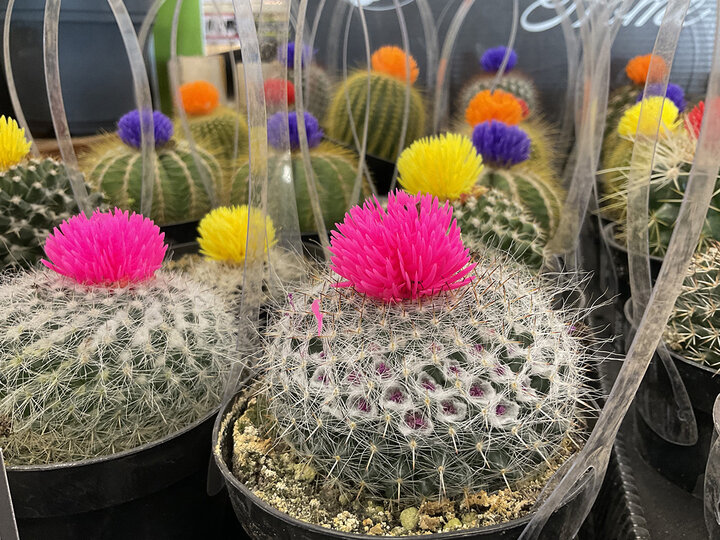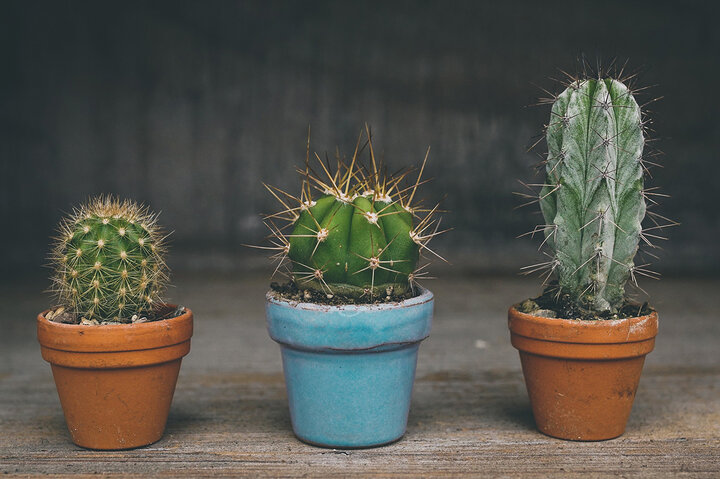Sarah Browning, Nebraska Extension Educator

Cactus flower buds. Image from Pixabay.com

It grates on my gardener’s soul to visit a big box store this time of year and see shelves of cacti each with a flower - in an array of colors - because (spoiler alert) most are glued-on straw or plastic flowers. Not real cactus flowers.
If you think about where cacti live in the wild, it's not surprising that they don't flower readily at this time of year in Nebraska! Low light, warm winter indoor temperatures and too much water are typical indoor winter conditions which are not ideal for desert plants – especially if you want them to flower.
To get your cacti to flower, turn those conditions around - provide bright light, cool temperatures and little to no water.

Choosing Your Cactus
To have success with cacti, obtain plants from a knowledgeable individual who can help you pick species that won't keep you waiting several years before flowers are a possibility. Or visit a garden center where plants are labeled accurately with botanical names. Families of cacti that bloom reliably indoors include the pincushion cactus (Mammillaria spp.), chin cactus (Gymnocalycium spp.), barrel cactus (Ferocactus spp.), Parodia spp. star cactus (Astrophytum spp.) and hedgehog cactus (Echinocereus spp.).
Cactus Care
A sunny south, southwest or west window is ideal. Cacti can go outside during the summer, just provide some protection from direct sun initially. It will take at least a couple weeks of partial sun for plants to develop thicker cell walls which prevent sunburn patches. Gradually acclimate plants to the brighter light outside.
To water cacti during the active growing season, June through September, soak the entire root ball thoroughly, but only when the top inch of the soil medium is dry. The surest way to kill cacti is to overwater them. Many will go several weeks between waterings, especially when they are watered thoroughly as described above. Plants must never be allowed to stand in water.
When plants need repotting, use a mixture with equal parts bird gravel or other aggregate, potting soil or sterilized garden loam, and leaf mold. The soil mixture must be well-drained, enabling water to move through the soil – not heavy and retaining moisture for a long period of time. Or purchase a commercial cactus soil mixture. But don't repot too often - cactus bloom better when allowed to be slightly pot bound.
Apply a low nitrogen fertilizer, such as 5-10-5, once a month from June through September.
Following these guidelines should keep your cacti healthy and growing well, but it won't necessarily make them flower.
Begin Flower Development through Dormancy
To initiate flowering, cacti must first go into a dormant period. Induce dormancy with a combination of cool temperatures – night temperatures ideally between 40 and 50 degrees F - and four to five hours of bright light daily. More sunlight is fine, but the cool temperatures are a must. Finding this set of conditions indoors can be a challenge, but might be found in one of the following sites.
- Cool, dry greenhouse
- Window-mounted mini-greenhouse
- Covered basement window well; place the cacti containers in the well, beneath the window cover
- Glass-enclosed porch
- Unheated upstairs bedroom
- Attached unheated garage
If you don't have a sunny cool spot, then work with what you have by adding light to a dark cool spot or closing a heat register to cool a sunny room.
Don’t let your plants freeze! Though cacti need chilly temperatures in the winter, most won't tolerate frost, so make sure the temperature in the space you've chosen stays above freezing.
For many houseplant gardeners, the hardest part about caring for dormant cacti is watering - or rather, not watering. Give them no water during the cold dormant period, from mid- to late November until March, unless plants begin to shrivel. Then make a light application of water. Place your cacti in that cool, brightly lighted spot and ignore them until the end of March. Do not fertilize plants during dormancy.
Watch for Real Flowers
If the plants aren't too young, they should flower in spring or early summer. Resume watering when the flowers start to show. Then begin tapering off again in late August to ease the plants back into their next dormant period.
Images
- Don't be fooled by plastic flowers glued on to these cacti. Image by Sarah Browning, Nebraska Extension.
- Use a well-drained soil mix when repotting cacti.
Images from Pixabay.com.
Search Our Archive
Associated Video
Succulents
Nebraska Extension Landscape Horticulture Specialist Kim Todd shows us some great succulents to try.